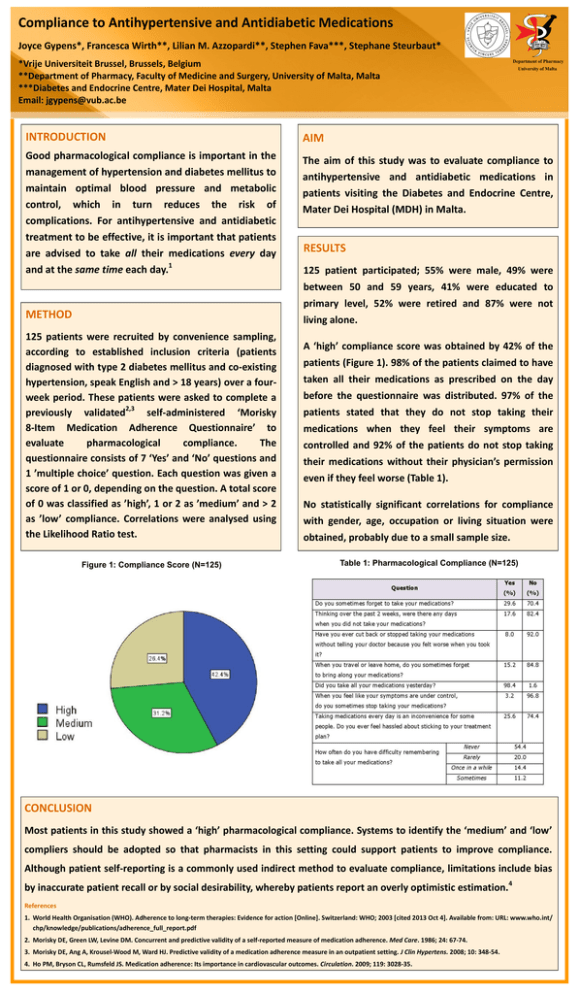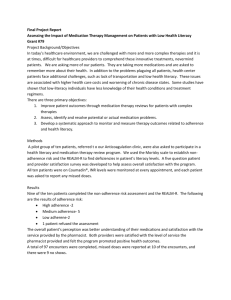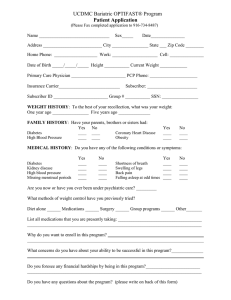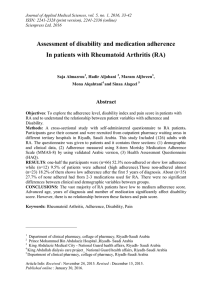Compliance to Antihypertensive and Antidiabetic Medications
advertisement

DEPARTMENT OF PHARM ACY UNIVERSI TY OF MA LTA Compliance to Antihypertensive and Antidiabetic Medications Joyce Gypens*, Francesca Wirth**, Lilian M. Azzopardi**, Stephen Fava***, Stephane Steurbaut* Department of Pharmacy *Vrije Universiteit Brussel, Brussels, Belgium **Department of Pharmacy, Faculty of Medicine and Surgery, University of Malta, Malta ***Diabetes and Endocrine Centre, Mater Dei Hospital, Malta Email: jgypens@vub.ac.be University of Malta INTRODUCTION AIM Good pharmacological compliance is important in the management of hypertension and diabetes mellitus to maintain optimal blood pressure and metabolic control, which in turn reduces the risk of complications. For antihypertensive and antidiabetic treatment to be effective, it is important that patients are advised to take all their medications every day 1 and at the same time each day. The aim of this study was to evaluate compliance to antihypertensive and antidiabetic medications in patients visiting the Diabetes and Endocrine Centre, Mater Dei Hospital (MDH) in Malta. RESULTS 125 patient participated; 55% were male, 49% were between 50 and 59 years, 41% were educated to primary level, 52% were retired and 87% were not METHOD living alone. 125 patients were recruited by convenience sampling, according to established inclusion criteria (patients diagnosed with type 2 diabetes mellitus and co-existing hypertension, speak English and > 18 years) over a fourweek period. These patients were asked to complete a 2,3 previously validated self-administered ‘Morisky 8-Item Medication Adherence Questionnaire’ to evaluate pharmacological compliance. The questionnaire consists of 7 ‘Yes’ and ‘No’ questions and 1 ’multiple choice’ question. Each question was given a score of 1 or 0, depending on the question. A total score of 0 was classified as ’high’, 1 or 2 as ’medium’ and > 2 as ’low’ compliance. Correlations were analysed using the Likelihood Ratio test. Figure 1: Compliance Score (N=125) A ‘high’ compliance score was obtained by 42% of the patients (Figure 1). 98% of the patients claimed to have taken all their medications as prescribed on the day before the questionnaire was distributed. 97% of the patients stated that they do not stop taking their medications when they feel their symptoms are controlled and 92% of the patients do not stop taking their medications without their physician’s permission even if they feel worse (Table 1). No statistically significant correlations for compliance with gender, age, occupation or living situation were obtained, probably due to a small sample size. Table 1: Pharmacological Compliance (N=125) CONCLUSION Most patients in this study showed a ‘high’ pharmacological compliance. Systems to identify the ‘medium’ and ‘low’ compliers should be adopted so that pharmacists in this setting could support patients to improve compliance. Although patient self-reporting is a commonly used indirect method to evaluate compliance, limitations include bias by inaccurate patient recall or by social desirability, whereby patients report an overly optimistic estimation. 4 References 1. World Health Organisation (WHO). Adherence to long-term therapies: Evidence for action [Online]. Switzerland: WHO; 2003 [cited 2013 Oct 4]. Available from: URL: www.who.int/ chp/knowledge/publications/adherence_full_report.pdf 2. Morisky DE, Green LW, Levine DM. Concurrent and predictive validity of a self-reported measure of medication adherence. Med Care. 1986; 24: 67-74. 3. Morisky DE, Ang A, Krousel-Wood M, Ward HJ. Predictive validity of a medication adherence measure in an outpatient setting. J Clin Hypertens. 2008; 10: 348-54. 4. Ho PM, Bryson CL, Rumsfeld JS. Medication adherence: Its importance in cardiovascular outcomes. Circulation. 2009; 119: 3028-35.







